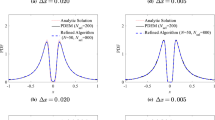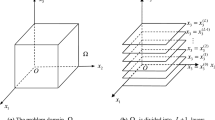Abstract
The reproducing kernel particle method (RKPM) is a widely used meshless method that has been extensively applied in numerical analysis. The drawback of RKPM is that when different kernel functions are chosen during the computation process, there are different calculation accuracy, and significant discreteness. To address this issue, the radial basis function is introduced to RKPM, and the radial basis reproducing kernel particle method (RB-RKPM) is proposed. The negative impacts of different kernel functions on calculation accuracy can be eliminated by RB-RKPM, which possesses some advantages, such as good convergence, high computational accuracy and efficiency. Furthermore, the RB-RKPM is applied to the damped elastic dynamics problems (DEDPs), the governing equations for the DEDPs are derived based on the weak integral formulation, and the time is integrated by using the Newmark-linear acceleration method. Finally, the correctness of the proposed method in analyzing the DEDPs is verified through numerical examples.



























Similar content being viewed by others
References
Abdoun F, Azrar L, Daya EM, Potier-Ferry M (2009) Forced harmonic response of viscoelastic structures by an asymptotic numerical method. Comput Struct 87(1–2):91–100
Azizpooryan M, Noormohammadi N, Boroomand B (2022) Equilibrated basis functions for static analysis of in-plane heterogeneous laminated composite plates in boundary and meshfree approaches. IJST Trans Mech Eng 46(4):957–984
Barcelos HM, Loeffler CF (2019) The direct interpolation boundary element method applied to smoothly inhomogeneous Laplace’s problems. Eng Anal Bound Elem 105:155–164
Chen XZ, Yu HT (2022) A multiscale method coupling peridynamic and boundary element models for dynamic problems. Comput Method Appl M 401(B):115669
Chen JS, Pan C, Wu CT (1996) Reproducing kernel particle methods for large deformation analysis of non-linear structures. Comput Method Appl Mater 139(1–4):195–227
Cheng YM, Chen MJ (2003) A boundary element-free method for linear elasticity. Acta Mech Sin Proc 35(2):181–186
Cheng YM, Li JH (2006) A complex variable meshless method for fracture problems. Sci China Ser G 49:46–59
Cheng YM, Wang WF, Peng MJ, Zhang Z (2014) Mathematical aspects of meshless methods. Math Probl Eng 2014:756297
Cheng YM, Bai FN, Liu C, Peng MJ (2016) Analyzing nonlinear large deformation with an improved element-free Galerkin method via the interpolating moving least-squares method. Int J Comput Mat Sci 5(4):1650023
Cheng H, Peng MJ, Cheng YM (2017) A fast complex variable element-free Galerkin method for three-dimensional wave propagation problems. Int J Appl Mech 9(6):1750090
David RW, Ben VR, Jae HL, Boyce EG (2023) A nodal immersed finite element-finite difference method. J Comput Phys 477:111890
Dehghan M, Abbaszadeh M (2017) Element free Galerkin approach based on the reproducing kernel particle method for solving 2D fractional Tricomi-type equation with Robin boundary condition. Comput Math Appl 73(6):1270–1285
Dumont NA (2023) The consistent boundary element method for potential and elasticity: part II -machine-precision numerical evaluations for 2D problems. Eng Anal Bound Elem 149:92–111
Freundlich J, Sado D (2023) Dynamics of a mechanical system with a spherical pendulum subjected to fractional damping: analytical analysis. Nonlinear Dynam 111(9):7961–7973
Gao HF, Wei GF (2019) Numerical solution of potential problems using radial basis reproducing kernel particle method. Results Phys 13:102122
Granger D, Ross A (2009) Effects of partial constrained viscoelastic layer damping parameters on the initial transient response of impacted cantilever beams: experimental and numerical results. J Sound Vib 321(1–2):45–64
Guan PC, Sun CT (2014) The isoparametric reproducing kernel particle method for nonlinear deformation of plates. Eng Anal Bound Elem 42:67–76
Huang ZC, Peng HY, Wang XG, Chu FL (2023) Finite element modeling and vibration control of plates with active constrained layer damping treatment. Materials 16(4):1652
Jankowska M, Kołodziej J (2016) A study of elastic-plastic deformation in the plate with the incremental theory and the meshless methods. J Mech Mater Struct 11(1):41–60
Kalamkarov AL, Kolpakov AG (2001) A new asymptotic model for a composite piezoelastic plate. Int J Solids Struct 38(34–35):6027–6044
Kostopoulos V, Korontzis DT (2003) A new method for the determination of viscoelastic properties of composite laminates: a mixed analytical–experimental approach. Compos Sci Technol 63(10):1441–1452
Kumar N, Singh S (2010) Experimental study on vibration and damping of curved panel treated with constrained viscoelastic layer. Compos Struct 92(2):233–243
Li SF, Hao W, Liu WK (2000) Mesh-free simulations of shear banding in large deformation. Int J Solids Struct 37(48–50):7185–7206
Liu D, Cheng YM (2020) The interpolating element-free Galerkin method for three-dimensional transient heat conduction problems. Results Phys 19:103477
Liu S, Li J, Chen L, Guan YJ, Zhang CS, Gao FZ, Lin J (2019) Solving 2D Poisson-type equations using meshless SPH method. Results Phys 13:102260
Liu Z, Gao HF, Wei GF, Wang ZM (2020a) The meshfree analysis of elasticity problem utilizing radial basis reproducing kernel particle method. Results Phys 17:103037
Liu Z, Wei GF, Wang ZM (2020b) The radial basis reproducing kernel particle method for geometrically nonlinear problem of functionally graded materials. Appl Math Model 85:244–272
Ma BA, He JF (1992) A finite element analysis of viscoelastically damped sandwich plates. J Sound Vib 152(1):107–123
Ma X, Zhou B, Li YJ, Sf X (2022) A Hermite interpolation element-free Galerkin method for elasticity problems. J Mech Mater Struct 17(1):75–95
Moita J, Araújo A, Martins P, Soares CM, Soares CM (2011) A finite element model for the analysis of viscoelastic sandwich structures. Comput Struct 89(21–22):1874–1881
Peng PP, Fu YD, Cheng YM (2021) A hybrid reproducing kernel particle method for three-dimensional advection-diffusion problems. Int J Appl Mech 13(7):2150085
Peng LX, Chen SY, Wei DY, Chen W, Zhang YS (2022) Static and free vibration analysis of stiffened FGM plate on elastic foundation based on physical neutral surface and MK method. Compos Struct 290:115482
Rallu A, Hans S, Boutin C (2018) Asymptotic analysis of high-frequency modulation in periodic systems. Analytical study of discrete and continuous structures. J Mech Phys Solids 117:123–156
Reddy JN (1989) An Introduction to the finite element method. J Press Vess Trans ASME 111(3):348–349
Sabahi MA, Saidi AR, Khodabakhsh R (2022) An analytical solution for nonlinear vibration of functionally graded porous micropipes conveying fluid in damping medium. Ocean Eng 245:110482
Salehi A, Ahmadi I (2022) Transient thermal and mechanical stress analysis of 2D-functionally graded finite cylinder: a truly meshless formulation. IJST Trans Mech Eng 46(3):573–598
Sanchez PE (1980) Non-homogeneous media and vibration theory, vol 320. Springer, pp 57–65
Sepehri-Amin S, Faal RT, Das R (2020) Analytical and numerical solutions for vibration of a functionally graded beam with multiple fractionally damped absorbers. Thin Wall Struct 157:106711
Sichani AB, Mehring C (2023) Boundary element method for modeling droplet deformation in secondary atomization. Eng Anal Bound Elem 152:51–65
Sun WX, Qu WZ, Gu Y, Zhao SD (2023) Meshless generalized finite difference method for two-and three-dimensional transient elastodynamic analysis. Eng Anal Bound Elem 152:645–654
Timesli A (2022) Optimized radius of influence domain in meshless approach for modeling of large deformation problems. IJST Trans Mech Eng 46(2):541–551
Vasques CMA, Mace B, Gardonio P, Rodrigues JD (2006) Arbitrary active constrained layer damping treatments on beams: finite element modelling and experimental validation. Comput Struct 84(22–23):1384–1401
Wang JG, Liu GR (2002) On the optimal shape parameters of radial basis functions used for 2-D meshless methods. Comput Method Appl M 191(23–24):2611–2630
Wang BH, Ma YQ, Cheng YM (2019) The improved complex variable element-free Galerkin method for bending problem of thin plate on elastic foundations. Int J Appl Mech 11(10):1950105
Wu CL, Zhang LL, Cui JH, Yin HM (2023) Three-dimensional elastic analysis of a bi-material system with a single domain boundary element method. Eng Anal Bound Elem 146:17–33
Zhang S, Zhu JL (2013) A projection iterative algorithm boundary element method for the Signorini problem. Eng Anal Bound Elem 37(1):176–181
Zhang X, Song KZ, Lu MW, Liu X (2000) Meshless methods based on collocation with radial basis functions. Comput Mech 26:333–343
Zhang LW, Zhu P, Liew KM (2014) Thermal buckling of functionally graded plates using a local Kriging meshless method. Compos Struct 108:472–492
Zhou XQ, Yu DY, Shao XY, Wang SJ, Zhang SQ (2015) Simplified-super-element-method for analyzing free flexural vibration characteristics of periodically stiffened-thin-plate filled with viscoelastic damping material. Thin Wall Struct 94:234–252
Acknowledgements
The work is supported by the Natural Science Foundation of Shandong Province (Grant No. ZR2020MA059).
Author information
Authors and Affiliations
Contributions
TL: Methodology, Software, Formal Analysis, Writing-Original Draft. GW: Data Curation, Conceptualization, Writing–Review & Editing. YZ: Funding acquisition, Validation, Investigation.
Corresponding author
Ethics declarations
Conflict of interest
The authors declared no potential conflicts of interest with respect to the research, authorship, and publication of this article. The authors declare that they have no conflict of interest.
Rights and permissions
Springer Nature or its licensor (e.g. a society or other partner) holds exclusive rights to this article under a publishing agreement with the author(s) or other rightsholder(s); author self-archiving of the accepted manuscript version of this article is solely governed by the terms of such publishing agreement and applicable law.
About this article
Cite this article
Liu, T., Wei, G. & Zhang, Y. Radial Basis Reproducing Kernel Particle Method for Damped Elastic Dynamics Problems. Iran J Sci Technol Trans Mech Eng (2023). https://doi.org/10.1007/s40997-023-00701-6
Received:
Accepted:
Published:
DOI: https://doi.org/10.1007/s40997-023-00701-6




